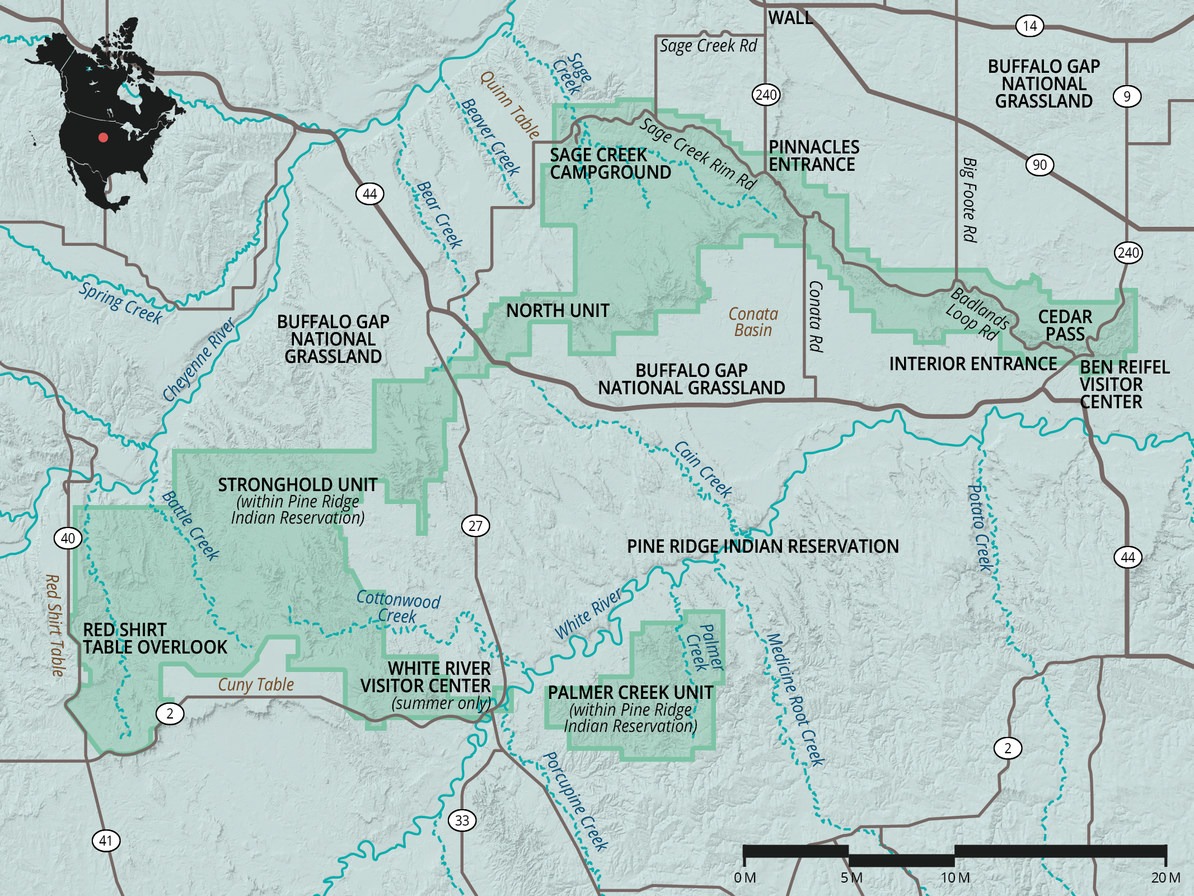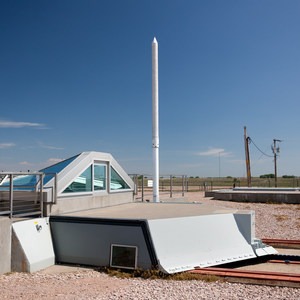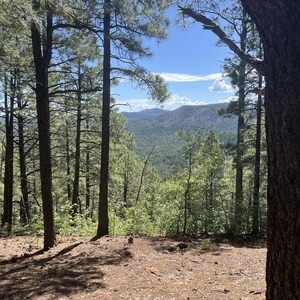You are here
Badlands National Park Overview | Hikes | Camping and Lodging | Weather | Pets
Badlands National Park Overview
Badlands National Park encompasses 244,000 acres of South Dakota badlands and grass prairie wilderness. Famous for the dry terrain comprised of sedimentary hoodoos, spires, and eroded buttes, the park is an otherworldly destination that boasts fascinating geology and some of the world’s richest fossil deposits. The park is split into two units: a north unit, which contains most of the federally developed park infrastructure, and a south unit, which falls within the boundaries of the Pine Ridge Indian Reservation, home of the Lakota Sioux.

Nearly 50 million years of geologic time are on display in the sedimentary rock layers in the Badlands. The oldest rock in the park is up to 75 million years old and dates to the Cretaceous Period, and in the millions of years hence the landscape has transformed from seabed to tropical forest to open woodland. Likewise, a wide variety of animal and plant remains have been locked in the layers of rock in the Badlands, and the world’s richest deposits of late Eocene and Oligocene epoch mammal fossil beds are found in the White River Badlands. At 23 to 35 million years old, the finds here include mammals long extinct from the North American continent: three-toed horses, camels, rhinoceroses, and oreodonts, similar to the tapir in appearance, among others. Over the last 500,000 years, the Cheyenne River watershed has slowly and persistently eroded the rock layers to create the striking canyons that attract visitors today.
With a plethora of overlooks along Badlands Loop Road, Badlands National Park is a motorist and cyclist destination. From the Ben Reifel Visitor Center, more than 30 miles of road connect the eastern and western boundaries of the park—more if you're connecting to the South Unit. Badlands is a fantastic bicycle camping destination.
In addition, the dark skies of Badlands National Park are some of the darkest in North America, and on clear nights as many as 7,500 stars are visible to the naked eye.
There are two visitor centers. The Ben Reifel Visitor Center, in the park’s northern section, is open year round. The White River Visitor Center, in the park’s southern section under Lakota Sioux management, is open only during the summer.
Hikes
Badlands National Park has few maintained trails, and the area is ripe for backcountry exploration. That said, there are a few notable trails to add to your to-do list.
Short trails:
- The Window Trail is a short quarter-mile hike to an eroded window in the Badlands Wall with a beautiful canyon view.
- The Notch Trail is a unique 1.5-mile out-and-back into eroded river canyons.
- The Door Trail leads 0.75 miles along a boardwalk through the Badlands Wall, where the maintained trail ends and hikers are free to explore at their own leisure.
- Fossil Exhibit Trail: There is no better spot to become acquainted with a few of the many species that lived in this area during the Oligocene age.
- Saddle Pass climbs 200 feet over a half mile, and a seasonal pond offers the opportunity to see the park’s wildlife.
- Saddle Pass is a quarter-mile trail that links with the Castle Trail and Medicine Root Loop.
- Deer Haven is the only wooded area in Badlands National Park and makes a great destination for a day hike.
Long trails:
- Castle Trail is the longest trail in the park at 5 miles one way. At its western terminus is the Fossil Exhibit Trail, an interpretive trail featuring exhibits of the park’s extinct animal life.
- Medicine Root Loop is a 4-mile spur off of the Castle Trail through grass prairie with cactus and wide views of the Badlands.
Camping and Lodging
The park has only two campgrounds:
The Cedar Pass Campground is located close to the Ben Reifel Visitor Center and has 96 sites available for reservation at $22 per campsite and $37 per campsite with electrical hookups. Amenities include running water, flush toilets, and picnic tables.
In the park’s more remote western reaches, the Sage Creek Campground offers dispersed camping free of charge. Amenities are limited to pit toilets and covered picnic tables. There is no running water. All sites are first-come, first-served.
There is no permit required for backcountry camping, nor is there a formal system for reservations. Campers are free to pitch a tent anywhere at least a half mile from any road or trail and not visible from park roads. Note that twisted or broken ankles are the most commonly reported injury in the Badlands backcountry. Also of note are the private lands in the South Unit. Wherever you plan a backcountry excursion, be sure to check in with rangers at the nearest visitor center.
Lodging
Cabins are available at Cedar Pass Lodge, located next to the Cedar Pass Campground. The Cedar Pass Restaurant serves breakfast, lunch, and dinner, although their hours vary depending upon time of year. Pet-friendly cabins are available for an extra $20 per night. Reservations can be made on their website.
Weather
The weather in Badlands National Park is unpredictable. Summers are very hot and winters are very cold. Be most wary of summer thunderstorms, which can drop hail and form tornadoes. June is the wettest month. December and January are the driest.
Also important to note: Sun exposure in the park is high where there is limited vegetation to provide relief from the sun. Prepare accordingly.
Pets
Pets are permitted in Badlands National Park with some restrictions. Pets cannot be left unattended. While visiting the park, pets must be kept on a leash no more than 6 feet in length at all times. Pets are only allowed in developed areas, such as campgrounds and picnic areas, and other areas open to motor vehicles, such as gravel and paved roadways, roadway corridors, and parking lots. Pet etiquette dictates always cleaning up animal waste and disposing of it in trash receptacles.
Pets are prohibited from hiking trails, public buildings (i.e. visitor centers), and backcountry areas, including the Badlands Wilderness Area and areas with prairie dog colonies. Leaving your animal unattended or tied to a fixed object is prohibited, and it is a danger to your pet.
Service dogs are the only exception to these rules. They are not allowed in areas with prairie dog colonies.








Comments
Sign In and share them.